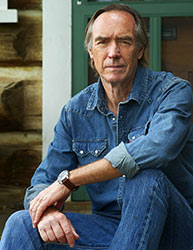One Thousand White Women Discussion Guide: Home
Jim Fergus
Articles, Interviews, and Reviews
Some article may require you to login with your library barcode number.
- Wild, Wild West: PW Talks with Jim FergusPublishers Weekly, March 28, 2005
Further Reading
More about the lives of women and Native Americans during the 19th Century.
Discussion Questions
From the publisher.
- The Cheyenne are often referred to as "savages," even by the women who voluntarily travel to live among them. During this time period, what is it that makes the Cheyenne savage, and the white "civilized"? Are there ways in which you would judge the Cheyenne in the novel are more civilized than the whites? Are there ways in which you consider them less civilized?
- Were you surprised that Little Wolf, the Cheyenne chief, was so aware and seemingly resigned to the fact that his culture was doomed? How does this differ from our attitudes and assumptions as United States citizens?
- Did you admire May Dodd's rebelliousness? Did you find it shocking that she would leave her children behind? Do you consider her a sympathetic character?
- Did you find it believable that the US government might undertake a covert project such as the "Brides for Indians" program? Do you think the author had more modern history in mind when he developed this idea?
- Were you surprised by elements of the Cheyenne Culture as depicted here?
- Do you think that the Cheyenne culture was respectful of women? Consider what might seem contradictory elements--for example, it is a matrilineal society, and yet warriors could have multiple wives.
- Compare what the Cheyenne culture valued in women compared with what white culture at the time valued in women. Contrast Captain Bourke's fiancée, Miss Lydia Bradley, with May Dodd. In what way do May and Lydia represent different types of women? In what ways have cultural expectations of women changed since this time period, and in what ways have they remained the same?
- Did you find it believable that the white women embraced the Cheyenne culture, and willingly married with them?
- Compare your concept of romantic love, and married love, with the relationship that develops between May and Little Wolf.
- Were you surprised by the violence among tribes as depicted here? Did it contrast with your understanding of Native American cultures? What similarities were there between the violence among tribes, and the violence between whites and Native Americans?
- While depicting the slaughter of Native American culture, Jim Fergus also portrays the imminent decimation of the natural landscape. Consider both tragedies. Were they equally inevitable? Are they equally irreversible?
Discussion Questions
From Reading Group Guides
1. One Thousand White Women was written by a man, but in a woman's point of view. Did you find this convincing?
2. In 1875, rebellious or unorthodox women were sometimes considered "hysterical" or insane. Is this still true in some circumstances today?
3. Does May Dodd remind you of a modern-day woman?
4. What would be today's equivalent of traveling west to an unknown part of the country with a group of strangers?
5. Did you feel the Native Americans were accurately portrayed in the novel?
6. If the "Brides for Indians" program were actually put into effect in 1875, do you feel it would have been effective?
7. What circumstances would prompt you to undergo a journey like the one May Dodd took?
8. Do you consider One Thousand White Women a tragic story? If so, why? If not, why not?
9. Of the supporting female characters, who did you find the most likeable?
10. Were any of May Dodd's actions unsympathetic? Would you find it difficult to leave your children behind in order to escape a horrendous situation?
Reserve a copy
Recommended Reading
If you liked One Thousand White Women, you might enjoy these evocative historical novels.
Mudbound by
Call Number: JORDAN



